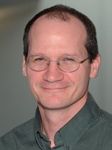
Please Note: The content on this page is not maintained after the colloquium event is completed. As such, some links may no longer be functional.
Dan Duffy
Counting Trees and Shrubs on the South Side of the Sahara using Cloud Computing
Wednesday, November 4, 2015
Building 3 Aud 11:00 AM
(Coffee and cookies at 10:30 AM)
As the combinations of remote sensing observations and model outputs have grown, scientists are increasingly burdened with both the necessity and complexity of large-scale data analysis. Scientists are increasingly applying traditional high performance computing (HPC) solutions to solve their "Big Data" problems. While this approach has the benefit of limiting data movement, HPC systems are optimized for large-scale simulations and not for data analysis.
To solve these issues and to alleviate some of the strain on the HPC environment, the NASA Center for Climate Simulation (NCCS) has created the Advanced Data Analytics Platform (ADAPT). ADAPT combines high performance computing and virtualization technologies to create an on-site private cloud specifically designed for large-scale data analytics. The NCCS has already deployed this system for use with a variety of Goddard research projects, including the Arctic Boreal Vulnerability Experiment (ABoVE). In order to extend this approach even further and to make this system as flexible as possible, the NCCS has coupled this private environment with a commercial cloud, namely Amazon Web Services (AWS). The result is a highly extensible and elastic hybrid cloud environment where users can start using systems and services at Goddard and burst into commercial clouds as needed.
In order to fully develop the hybrid cloud approach, the NCCS partnered with Dr. Compton Tucker (NASA Goddard) and Dr. Paul Morin (Univ. of Minnesota) on a project to estimate the tree and bush biomass over the entire arid and semi-arid zone on the south side of the Sahara. Drs. Tucker and Morin submitted a proposal to the Intel Head in the Clouds Challenge and were subsequently awarded a research grant for compute and storage capabilities in AWS. In order to estimate the amount of carbon stored and create a baseline for future research, approximately 100 terabytes of high resolution National Geospatial-Intelligence Agency (NGA) imagery must be analyzed. Since the ADAPT system cannot be dedicated to this project and must meet the requirements for several research teams, it will take approximately ten months of time to analyze all the data on NASA resources. Through the use of the hybrid cloud approach of combining local resources with AWS, the goal of this project is to finish the analysis in one month of time. This talk will motivate the need for hybrid cloud resources within NASA and highlight the information technology infrastructure being put in place that will dramatically speed up science.
Dr. Dan Duffy is head of the NASA Center for Climate Simulation (NCCS, Code 606.2), which provides high performance computing, storage, networking, and data systems designed to meet the specialized needs of the Earth science modeling communities. He has worked on a number of applied research and development projects to explore technologies for the next generation of high performance computing solutions for NASA scientists, including being the co-Investigator on the MERRA Analytics Service Project, which has lead to the formulation of Climate Analytics-as-a-Service (CAaaS). Prior to being the high performance computing lead, Dan served as the lead system engineer for the NCCS over the past 10 years where he has architected dramatic increases in computational and storage capabilities for NASA scientists. Before joining NASA in 2003, Dan worked on highly parallel applications for the Department of Defense (DoD). Dr. Duffy received undergraduate degrees in Physics and Computer Science from Western Kentucky University in 1990, M.S. in Physics and M.S. in Science Education from Florida State University in 1993, and his Ph.D. in theoretical physics from Florida State University in 1997. Dr. Duffy's research in physics focused on the properties of highly correlated electron systems with a specific focus toward a better understanding of high temperature superconductivity. Dr. Duffy has also taught high school physics, undergraduate physics (during his post doctoral work at the University of Santa Barbara), and has given tutorials on parallel methods for high performance applications.
IS&T Colloquium Committee Host: Keith Keller
Sign language interpreter upon request: 301-286-7040
Request future announcements
